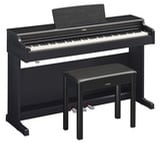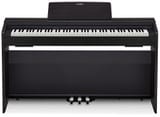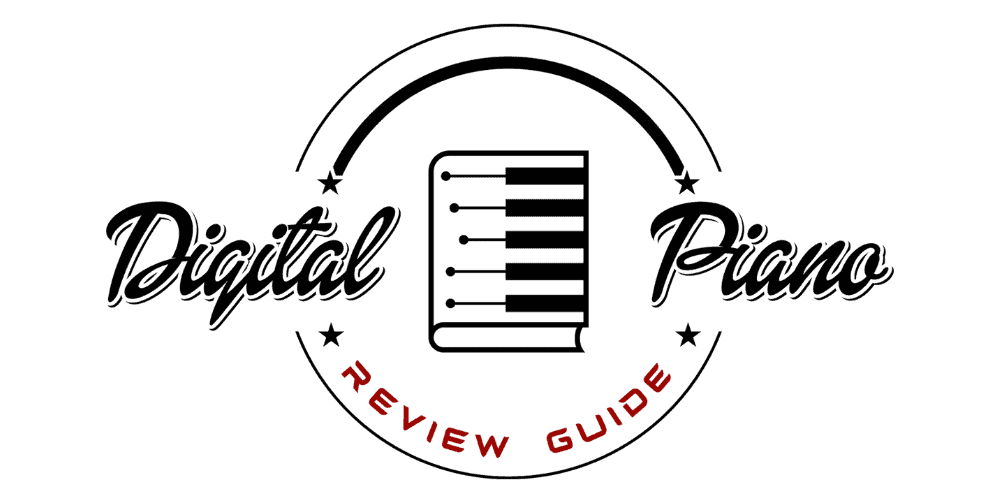Yamaha CSP-150 review

You’re thinking of buying a digital piano, but with so many choices out there you feel a bit bewildered. If you ask anyone who knows digital pianos, most will tell you that among the best digital piano brands on the market is definitely the Yamaha brand. And with pianos like the Yamaha CSP-150 on the market, it’s easy to see why.
Let’s talk about a few things that you need to know before I actually present specific models of Yamaha digital pianos. There are many factors that you should consider before selecting an instrument to purchase or rent.
Here are just a few:
- Price
- For whom is the piano intended?
- Space available for an instrument
- Features you need
- Features you want
And to better help you, we’ve compiled an interactive table below that allows you to directly compare the Yamaha CSP-150 to other notable digital pianos on the market.
| Photo | Model |
|---|---|
 | Yamaha CLP 735 |
 | Yamaha YDP 144 |
 | Casio PX-770 |
 | Yamaha YDP-165 |
 | Casio PX-870 |
 | Roland RP-102 |
Let’s begin our Yamaha CSP-150 review by first talking about price.
Price of the Yamaha CSP-150
The Yamaha CSP-150 goes for about $3,499.99.
Obviously, price is an important factor when buying a piano or any musical instrument. A good rule of thumb is to buy the best piano you can afford. If money is a serious concern, then consider renting a piano for a specified time.
Many retailers cater to parents who wish to rent musical instruments for school; why not approach your local piano retailer and find out if they have a rental option for pianos? Some dealers may have a rent-to-own option that allows you to find out if playing the piano is truly what you or a child may wish to do.
If so, your rental payments will apply to the purchase price. If playing the piano is not your ‘cup of tea,’ so to speak, then the dealer picks up the piano and you can try again with the guitar or zither or whatever you wish.
Whichever path you choose to piano ownership, make certain that you choose the best piano within your budget. If money isn’t so much of a concern, that doesn’t mean you should buy a nine-foot concert grand acoustic or the most expensive digital piano just because of its price tag.

And below, please take a moment to view some of the best selling digital pianos online, and see how well they stack up to the Yamaha CSP-150.
| BEST SELLERS |
|---|
| 1) Casio PX-770 |
| 2) Yamaha YDP-145 |
| 3) Roland RP-701 |
| 4) Yamaha YDP-165 |
| 5) Casio PX-870 |
For Whom is the Piano Intended?
Yeah, don’t buy a nine-foot concert grand for a six-year-old who wants to learn to play “Chopsticks.” (As a long-term piano teacher, if I had a nickel for every time I heard that piece…)
Let’s consider some likely scenarios:
- You are an accomplished pianist who wishes to up your skills, or you’re going back to school to (maybe) finish a degree in piano performance or pedagogy
- You have a highly musical six-year-old son/daughter whom you suspect may be a prodigy
- You have a six-year-old child who has never played the piano but says they would like to learn
- You have five children, some of whom would like to ‘noodle around’ with the piano and some of whom want to play the drums
- You are a piano teacher looking to liven up your lessons for your students
In example number 1, you will need the highest quality digital piano you can possibly afford. Consider a hybrid piano or a high-quality acoustic piano. For the truly serious, motivated student of advanced skills, you need the absolutely authentic touch of an acoustic piano or hybrid digital.
A hybrid piano the mechanical workings of an acoustic piano combined with the technological savvy/features of a high-quality digital piano. The mechanical workings give the hybrid piano its purely authentic acoustic touch that even the finest digital piano can’t quite manage to duplicate (so far), yet the digital capabilities bring a dimension of experimentation and possibilities to the instrument that provides entertainment and composition options unbeaten by an acoustic piano.
In example 2, please, please, PLEASE consult with a musical professional before you decide your child is a prodigy! I’ve dealt with those kinds of parents, and believe me, if their little darlings are not prodigy material they become real pains in the butt if they won’t accept that harsh reality.
In my 30+ years of teaching, I’ve had maybe 3 students who could truly qualify as prodigies. I’ve lost touch with two of them, but the third is a highly-respected professional musician and composer now. So make absolutely certain of your child’s prodigy-ness before you spend a boatload of money on a piano. If you are correct in your assessment of your child’s skills and motivation, then see my response to example 1.
In examples 3 and 4, consider purchasing one of the less expensive models I’ll present to you today. And in the case of example number 4 above, consider purchasing electronic drums to preserve your eardrums (they have headphones!) and your sanity.
If example 5 is your situation, then this article will definitely apply to you. The old ‘traditional’ means of teaching piano may work for some of your students, but many of them might require some further motivation and enhancements to get the most of out of their piano education. These situations are where the wise piano teacher learns to go with the flow and invest in a midrange-priced digital piano with educational possibilities. I’ll talk more about this later.
Space Available for the Instrument
This point seems rather intuitive to me. If you live in an apartment or small house, you’ll need to look at pianos that won’t require a lot of space. Digital pianos fit beautifully in these scenarios. With some of the beautiful cabinetry now available in the world of digital pianos, they also look attractive in a large home.
Features You Need
Headphones are a given; I couldn’t find a single digital piano in Yamaha’s lines or any other brand that didn’t have headphone capability. Some pianos offer dual headphones, which is a really great feature if you want to listen to the music your musician is making or help them in any way with rhythms, counting, etc.
I strongly recommend three integrated pedals as well. Using the pedals becomes a vital part of understanding piano technique, so it’s best to have all three pedals with a half-pedal function, if possible.
Features You Want
This category is what I call the “Montana sky” category: it’s as big as all outdoors!
For kids just wanting to ‘noodle around’ on the piano, the more bells and whistles you have on your instrument, the better. For a young musician who discovers that their motivation is missing, multiple voices on a piano could help them rekindle their love and appreciation for the piano…and they’re really fun to play with, if you’re an adult student! Just like Montana, the sky is the limit in this category.
Now let’s talk about a specific model: the Yamaha CSP 150. I’ll share with you its features, and then I’ll compare it to three other Yamaha models.
I fell in love with the CSP 150 when I saw it in my local piano show room.

Look at the clean lines of this beautiful and multi-function instrument! The iPad is sold separately, and it allows the musician to connect to Yamaha’s Smart Pianist app and control all of the instrument voices, rhythm tracks, effects, and so much more on this Clavinova. Smart Pianist doesn’t just control the piano, however. It provides many ways of interacting with the CSP 150’s features, true, but it also allows the musician access to many pieces of music that may be of interest to a pianist. You can play along with the pre-recorded pieces, or you can compose and play your own music. You can learn about piano chords and how they are used on this instrument.
On the CSP line of Clavinovas, Smart Pianist will also create a musical score by using the songs on your smart device. This feature is called “Audio to Score,” and it is found only on the CSP line. By creating a musical score, the piano allows you to play along with your favorite songs on your smart device.
I love the simplicity of this cabinet as well. No bells and whistles here, just a very simple and clean look. If you’re looking for an instrument that looks more like a piano than digital, this instrument or its counterpart, the CSP 170, may be for you.

There are a few minor differences between these pianos. For example, the CSP 170 features four 45-watt speakers, and the CSP 150 only has two 30-watt speakers. The CSP 150 is about $1,500 to $2,000 less expensive than the 170. The CSP 170 features natural wooden keys, while the CSP 150 has synthetic ivory and ebony key tops. Otherwise, these two pianos are virtually the same.
Compare the CSP 150 to the CLP 635 or CSP 645. The 635 is another piano with very clean lines, as is the CSP 645. The 645 features wooden white keys with synthetic key tops for both white and black keys. The 635 offers the Graded Hammer 3X keyboard with synthetic ivory and ebony key tops. The CLP 645 offers Bluetooth connectivity as well and Smart Pianist capability, although the Audio to Score option is not available on the CLP 645.

This picture of the CLP 645 resembles the CLP 635. The following pictures show that the display areas on the left side of both pianos are identical.
First the CLP 635:

Now the CLP 645:

These two instruments are almost identical in features as well. They have the same number of voices, the same number of songs, the same data capacity, and the same polyphony, among other things.
The primary differences that I could find between these two instruments are the number and wattage of the speakers. The CLP 635 offers two 30-watt speakers in its cabinetry. The CLP 645 offers four 25-watt speakers.
The retail prices seem to indicate the differences in the speakers, with the CLP 645 retailing for $1,000 to $1,500 more than the CLP 635. However, at my local piano store the salesman explained to me that they keep the CLP 635 next to an Arius piano for the purpose of allowing prospective buyers the chance to play each instrument. Then they offer to reduce the price of the CLP 635 to that of the Arius in order to allow the buyer to get the best piano they can for the money.
Let’s break this down this way:
For a beginning piano student, for price and capability, I give the CLP 635 the following rating—4.5 out of 5 stars.
For a beginning or intermediate student, the CLP 645 edges out the 635 with a rating of 4.75 out of 5 stars. The larger number of speakers offers a better sound experience than the 635, although the price is greater.
For an advanced student or a piano teacher wishing to upgrade their instrument for continued studies or enhanced educational features, I give the CSP 150 5 out of 5 stars. Yes, the CSP 170 offers more speakers, but the difference in speakers does not compensate for the increased price.
If you enjoyed this article, we’d love for you to “like” our Digital Piano Review Guide Facebook page!
You May Also Want to Read:
- The 7 Best Yamaha Arius Digital Pianos in 2019 That Sound Great
- Casio vs Yamaha Keyboards 2019: Best Digital Pianos Today?
- Keyboard or Piano for Beginners in 2019: Find the Best Digital Pianos Available
- The 11 Best Headphones for Digital Pianos in 2019 That Are Top Shelf
- The 8 Best Synthesizer Keyboards Under $1,000 That Are Amazing
- Yamaha CSP-170 review
- Yamaha NU1X review: Best Hybrid Piano?
- This article was written by Digital Piano Review Guide contributor Anita Elliott.






